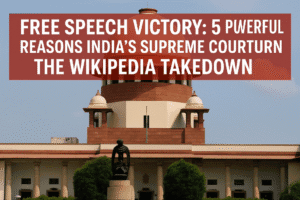Free Speech Victory: 5 Powerful Reasons India’s Supreme Court Overturned the Wikipedia Takedown
In a pivotal victory for digital rights, India’s Supreme Court overturned a Delhi High Court order directing Wikimedia to remove a Wikipedia page detailing a defamation case against news agency ANI, affirming free speech as a cornerstone of democracy. The dispute arose after ANI sued Wikimedia in 2024, alleging a page labeling it a “propaganda tool” for the government was defamatory. Rejecting the takedown as disproportionate, the apex court stressed that courts, as public institutions, must remain open to scrutiny, citing the necessity for transparency to uphold judicial integrity.
Quoting the Mirajkar precedent, the bench emphasized that public debate safeguards fairness in justice delivery, applying a stringent “necessity and proportionality” test to curb censorship overreach. The ruling reinforces Article 19 protections, curbs misuse of defamation laws to silence criticism, and underscores the judiciary’s role in balancing reputational concerns with democratic discourse. Legal experts hailed the decision as a safeguard against chilling online expression, promoting accountability in an era where digital platforms increasingly shape public opinion.
By prioritizing open dialogue over censorship, the verdict strengthens India’s commitment to a free, informed society—where media and courts collaborate, not clash, in upholding constitutional values.

Free Speech Victory: 5 Powerful Reasons India’s Supreme Court Overturned the Wikipedia Takedown
In a decisive victory for digital free speech, India’s Supreme Court on Friday struck down a lower court order demanding the removal of a Wikipedia page about a defamation lawsuit involving news agency Asian News International (ANI). The ruling, rooted in the constitutional right to free expression, reinforces the judiciary’s role in safeguarding public discourse and transparency in a democracy.
Background: A Clash Over Criticism and Censorship
The dispute began in 2024 when ANI sued the Wikimedia Foundation over a Wikipedia entry labeling the agency a “propaganda tool” for India’s central government. ANI argued the description was defamatory, prompting the Delhi High Court to order the page’s removal. The court further warned that discussing its ruling could amount to contempt—a move critics argued stifled legitimate debate.
Wikimedia appealed, contending the takedown order imposed a “chilling effect on free speech” and set a dangerous precedent for online expression. The case reached the Supreme Court, where justices weighed the balance between protecting reputations and upholding India’s constitutional commitment to open dialogue.
Supreme Court’s Reasoning: Transparency Over Censorship
A bench led by Justices Abhay S. Oka and Ujjal Bhuyan overturned the Delhi High Court’s directive, emphasizing that judicial processes must withstand public scrutiny. Quoting the landmark Naresh Shridhar Mirajkar v. State of Maharashtra verdict, the court affirmed that “public scrutiny acts as a check against judicial vagaries” and fosters trust in the justice system.
The ruling hinged on the “twin test of necessity and proportionality,” a legal standard requiring restrictions on speech to address only “real and substantial risks” to fair trials or justice administration. The court found the takedown order disproportionate, noting that courts, as public institutions, must remain open to criticism: “In a liberal democracy, judiciary and media must support each other.”
Implications: A Win for Digital Rights and Democratic Discourse
The decision carries significant ramifications:
- Reinforcing Article 19 Protections: By prioritizing free speech under Article 19 of the Indian Constitution, the ruling limits the use of defamation claims to suppress critical content, especially against public entities.
- Curbing Judicial Overreach: The “necessity and proportionality” test sets a higher bar for future takedown orders, discouraging courts from issuing broad censorship mandates.
- Strengthening Public Accountability: The court’s emphasis on transparency signals that judicial processes should welcome—not fear—public debate, reinforcing democratic checks on power.
Legal experts hailed the judgment as a safeguard against the weaponization of defamation laws. “This ruling acknowledges that criticism of public figures and institutions is integral to democracy,” said Apar Gupta, a digital rights advocate. “It curbs the trend of using courts to silence dissent through strategic litigation.”
Broader Context: Free Speech in India’s Digital Age
India has grappled with balancing free expression and online regulation amid rising demands for content removal under IT Act provisions and defamation laws. Recent years have seen increased legal battles over takedowns, from political satire to investigative reporting. The Supreme Court’s stance aligns with global digital rights principles, such as the UN’s emphasis on proportionality in content moderation.
However, challenges persist. Critics note that lower courts often lack clarity on applying free speech standards, leading to inconsistent rulings. Advocates urge legislative reforms to align defamation laws with modern democratic values, ensuring they protect individuals without enabling censorship.
Conclusion: A Precedent for Open Dialogue
The Wikimedia-ANI case underscores the tension between reputation management and free speech in the digital era. By siding with transparency, India’s Supreme Court has reaffirmed that open debate—even when uncomfortable—is the lifeblood of democracy. As Justice Oka noted, courts must resist the urge to insulate themselves from public “observations, debates, and criticisms,” recognizing that accountability strengthens, rather than undermines, judicial integrity.
This ruling not only shields platforms like Wikipedia from overbroad censorship but also empowers citizens to engage critically with institutions—a cornerstone of India’s constitutional democracy.
You must be logged in to post a comment.